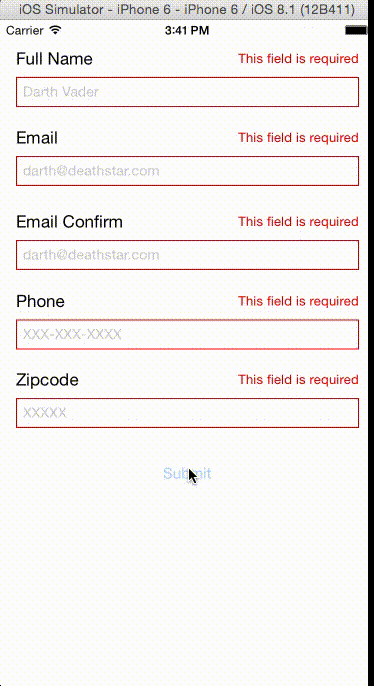- August 28, 2025
- Mins Read
Swift Validator is a rule-based validation library for Swift.
Core Concepts
UITextField+[Rule]+ (and optional errorUILabel) go intoValidatorUITextField+ValidationErrorcome out ofValidatorValidatorevaluates[Rule]sequentially and stops evaluating when aRulefails.
Installation
# Podfile
source ‘https://github.com/CocoaPods/Specs.git’
platform :ios, “8.1”
use_frameworks!
# Swift 4.2
pod ‘SwiftValidator’, :git => ‘https://github.com/jpotts18/SwiftValidator.git’, :tag => ‘4.2.0’
# Swift 3
# Extended beyond UITextField
pod ‘SwiftValidator’, :git => ‘https://github.com/jpotts18/SwiftValidator.git’, :branch => ‘master’
# Swift 2.1
# Extended beyond UITextField
# Note: Installing 4.x.x will break code from 3.x.x
pod ‘SwiftValidator’, :git => ‘https://github.com/jpotts18/SwiftValidator.git’, :tag => ‘4.0.0’
# Swift 2.1 (limited to UITextField validation)
pod ‘SwiftValidator’, :git => ‘https://github.com/jpotts18/SwiftValidator.git’, :tag => ‘3.0.5’
Install into your project:
$ pod install
Open your project in Xcode from the .xcworkspace file (not the usual project file):
$ open MyProject.xcworkspace
If you are using Carthage you will need to add this to your Cartfile
github “jpotts18/SwiftValidator”
Usage
You can now import SwiftValidator framework into your files.
Initialize the Validator by setting a delegate to a View Controller or other object.
// ViewController.swift
let validator = Validator()
Register the fields that you want to validate
override func viewDidLoad() {
super.viewDidLoad()
// Validation Rules are evaluated from left to right.
validator.registerField(fullNameTextField, rules: [RequiredRule(), FullNameRule()])
// You can pass in error labels with your rules
// You can pass in custom error messages to regex rules (such as ZipCodeRule and EmailRule)
validator.registerField(emailTextField, errorLabel: emailErrorLabel, rules: [RequiredRule(), EmailRule(message: “Invalid email”)])
// You can validate against other fields using ConfirmRule
validator.registerField(emailConfirmTextField, errorLabel: emailConfirmErrorLabel, rules: [ConfirmationRule(confirmField: emailTextField)])
// You can now pass in regex and length parameters through overloaded contructors
validator.registerField(phoneNumberTextField, errorLabel: phoneNumberErrorLabel, rules: [RequiredRule(), MinLengthRule(length: 9)])
validator.registerField(zipcodeTextField, errorLabel: zipcodeErrorLabel, rules: [RequiredRule(), ZipCodeRule(regex : “\\d{5}”)])
// You can unregister a text field if you no longer want to validate it
validator.unregisterField(fullNameTextField)
}
Validate Fields on button tap or however you would like to trigger it.
@IBAction func signupTapped(sender: AnyObject) {
validator.validate(self)
}
Implement the Validation Delegate in your View controller
// ValidationDelegate methods
func validationSuccessful() {
// submit the form
}
func validationFailed(_ errors:[(Validatable ,ValidationError)]) {
// turn the fields to red
for (field, error) in errors {
if let field = field as? UITextField {
field.layer.borderColor = UIColor.red.cgColor
field.layer.borderWidth = 1.0
}
error.errorLabel?.text = error.errorMessage // works if you added labels
error.errorLabel?.isHidden = false
}
}
Single Field Validation
You may use single field validation in some cases. This could be useful in situations such as controlling responders:
// Don’t forget to use UITextFieldDelegate
// and delegate yourTextField to self in viewDidLoad()
func textFieldShouldReturn(textField: UITextField) -> Bool {
validator.validateField(textField){ error in
if error == nil {
// Field validation was successful
} else {
// Validation error occurred
}
}
return true
}
Custom Validation
We will create a SSNRule class to show how to create your own Validation. A United States Social Security Number (or SSN) is a field that consists of XXX-XX-XXXX.
Create a class that inherits from RegexRule
class SSNVRule: RegexRule {
static let regex = “^\\d{3}-\\d{2}-\\d{4}$”
convenience init(message : String = “Not a valid SSN”){
self.init(regex: SSNVRule.regex, message : message)
}
}
GitHub
- August 27, 2025
- SwiftUI
This package provides you with an easy way to show tooltips over any SwiftUI view, since Apple does not provide ...
- August 27, 2025
- SwiftUI
- Uncategorized
SimpleToast is a simple, lightweight, flexible and easy to use library to show toasts / popup notifications inside iOS or ...
- August 27, 2025
- SwiftUI
Create Toast Views with Minimal Effort in SwiftUI Using SSToastMessage. SSToastMessage enables you to effortlessly add toast notifications, alerts, and ...




